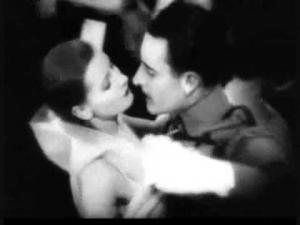- Historical Dance
- Jazz Age Social Dancing ("The Modern Dances")
- 0. The Essentials of Jazz Age Ballroom Dancing
- 1. Foxtrot Part 1: The Jazz Age Foxtrot
- 2. Youth Dancing in the Jazz Age
- 3. The Jazz Age Waltz
- 4. The Jazz Age Tango
- 5. 1930s Rumba
- 6. 1930s Samba
- 7. 1930s Conga
- 8. Bal Musette: Parisian Dance of the Jazz Age
- 9. Dancing in Weimar Berlin
- Dancing Made Easy - 1922
- Film Library - Jazz Age Dance
- Historical Dance Films posted to Pinterest
- Jazz Age Dance - Apologia
- Jazz Age Dance Image Collection
- Jazz Age Lead and Follow
- Places to Dance in Southern California in the Jazz Age
- Sampler of Jazz Age Dance Holds
- The Pathé Historical Dance Collection: 1920s-40s
- Ragtime Dance - the One Step
- Regency Dance
- Victorian Dance
- Jazz Age Social Dancing ("The Modern Dances")
1930s Viennese Waltz
 I am frequently asked, when discussing the Waltzes of the "Jazz Age", what they were doing in the time between the World Wars in the spiritual home of the Waltz: old Vienna.
I am frequently asked, when discussing the Waltzes of the "Jazz Age", what they were doing in the time between the World Wars in the spiritual home of the Waltz: old Vienna.
There certainly appears to have been a Viennese style of Waltz in use at the time that was distinctly different from the "Modern Waltz" so popular in the US and Britain. The "Modern Waltz" with its walking steps and box-step back-and-forth sway had rotation (often intermittent) as an option. In Vienna, it was all about the rotation and the faster the better - aimed at a sense of swirling and floating across the floor.
My working hypothesis, supported by admittedly thin data, is that the Viennese style predominated in Austria and Eastern Europe (Poland, Czechoslovakia etc.) It also seems to have been a choice at formal, white tie sorts of balls in Germany. However, it looks like the "Modern Waltz" was predominant on the floors of fashionable Berlin nightclubs - and it also works better on a crowded floor.
There also seems to have been interest in Britain in a Viennese-influenced style of Waltz (also known as "Old Time Waltz") in some venues - with even the occasional Polka. (Pathe newsreel: Playtime at Piccadilly)
So, here is some of my rather sparse data set: a clip from 1934 from an Austrian film. It depicts a very kinetic, fast moving rotary Waltz in the 19th Century tradition, combined with the intimate close hold of the Jazz Age. With this fast rotation and close hold, the turns are very tight, like spinning on the head of a pin.
It's followed by a clip from a Polish film from the '30s.
I find it interesting that the dancers in the first clip do most of the visible portions of the Waltz in a reverse rotation.
He begins: rock right, rock left, take a long step back with his right, begin rotation by advancing his left.
From the Polish film "Pani minister tańczy " (1937)
